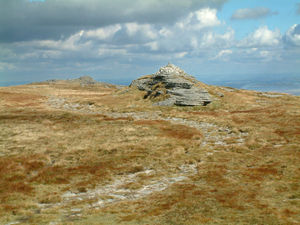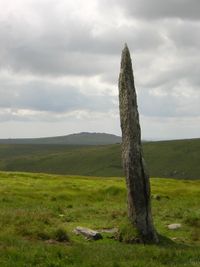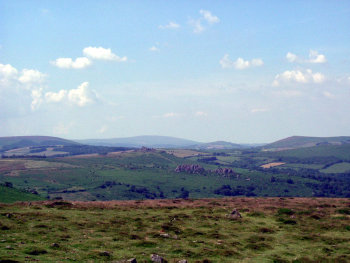Dartmoor
2007 Schools Wikipedia Selection. Related subjects: Geography of Great Britain

Dartmoor is an area of moorland in the centre of the English county of Devon. Protected by a National Park, it covers 953 km² (368 square miles).
The granite upland dates from the Carboniferous period of geological history. The moorland is capped with many exposed granite hilltops (known as tors), providing habitats for Dartmoor wildlife. The highest point is High Willhays, 621 m above sea level. The entire area is rich in antiquities.
Dartmoor is managed by the National Park Authority whose 26 members are drawn from Devon County Council, local District Councils and Government.
Parts of Dartmoor have been used as a military firing range for over 200 years. The public enjoy extensive access rights to the rest of Dartmoor, and it is a popular tourist destination. The Park was featured on the TV programme Seven Natural Wonders as the top natural wonder in South West England.
Geographical information
Tors
Dartmoor is known for its tors — large hills, usually topped with rocks. There are over 160 tors on Dartmoor. They are the focus of an annual event known as the Ten Tors, when over a thousand people, aged between 14 and 21, walk for distances of 35, 45 and 55 miles. While many of these hills do have the word "Tor" in them quite a number do not. This does not appear to relate to whether there is an outcrop of rock on them.
The highest points on Dartmoor are High Willhays ( grid reference SX580895, 621 m) and Yes Tor ( grid reference SX581901, 619 m) on the nothern moor. Eylesbarrow ( grid reference SX600685, 454 m) and Ryder's Hill ( grid reference SX690660, 515 m) are the highest points on the southern moor. Probably the best known tor on Dartmoor is Hay Tor (also spelt Hey Tor) ( grid reference SX757771, 457 m). For a more complete list see List of Dartmoor tors and hills.
Rivers
The levels of rainfall on Dartmoor are considerably higher than in the surrounding lowlands. With much of the national park covered in thick layers of peat, the rain is usually absorbed quickly and distributed slowly, so that the moor is rarely dry.
In some areas, where water accumulates, dangerous bogs or mires can result. Some of these, topped with bright green moss and known to locals as 'feather beds', will shift (or 'quake') beneath your feet — the result of pockets of air trapped beneath the surface.
Another consequence of the high rainfall is that there are numerous rivers and streams on Dartmoor. As well as shaping the landscape, these have traditionally provided a source of power for moor industries such as tin mining and quarrying.
The Moor takes its name from the River Dart, which starts as the East Dart and West Dart and then becomes a single river at Dartmeet. Other significant rivers which rise within the national park include:
|
|
|
|
History
Pre-history
The majority of the prehistoric remains on Dartmoor date back to the late Neolithic and early Bronze Age. Indeed, Dartmoor contains the largest concentration of Bronze Age remains in the United Kingdom, which suggests that this was when a larger population moved onto the hills of Dartmoor.
The climate at the time was warmer than today, and much of today's moorland was covered with trees. The prehistoric settlers began clearing the forest, and established the first farming communities.
The nature of the soil, which is highly acidic, means that no organic remains have survived. However, by contrast, the high durability of the natural granite means that their homes and monuments are still to be found in abundance, as are their flint tools. It should be noted that a number of remains were "restored" by enthusiastic Victorians and that, in some cases, they have placed their own interpretation on how an area may have looked.
Numerous menhirs (more usually referred to locally as standing stones or longstones), stone circles, kistvaens, cairns and stone rows are to be found on the moor. The most significant sites include:
- Beardown Man, near Devil’s Tor — isolated standing stone (3.5 m high, said to have another 1 m below ground). grid reference SX596796
- Challacombe, near the prehistoric settlement of Grimspound — triple stone row. grid reference SX689807
- Drizzlecombe, east of Sheepstor village — stone circles, rows, standing stones, kistvaens and cairns. grid reference SX591669
- Grey Wethers, near Postbridge — double circle, aligned almost exactly north south. grid reference SX638831
- Laughter Tor, near Two Bridges — standing stone (2.4 m high) and two double stone rows (one 164 m long). grid reference SX652753
- Merrivale, between Princetown and Tavistock — includes a double stone row (182 m long, 1.1 m wide, aligned almost exactly east-west), stone circles and a kistvaen. grid reference SX554747
- Scorhill, west of Chagford — circle (26.8 m in circumference) and stone rows. grid reference SX654873
- Shovel Down, north of Fernworthy reservoir — double stone row (approx 120 m long). grid reference SX660859
There are also an estimated 5,000 hut circles still surviving today, despite the fact that many have been raided over the centuries by the builders of the traditional dry stone walls. These are the remnants of Bronze Age houses. The smallest are around 6 ft (1.8 m) in diameter, and the largest may be up to five times this size.
Some have L-shaped porches to protect against wind and rain — some particularly good examples are to be found at Grimspound. It is believed that they would have had a conical roof, supported by timbers and covered in turf or thatch.
Many ancient structures, including the hut circles at Grimspound, were reconstructed during the 19th century — most notably by civil engineer and historian Richard Hansford Worth. Some of this work was based more on speculation than archaeological expertise, and has since been criticised for its inaccuracy.
The historical period
The climate worsened over the course of a thousand years from around 1000 BC, so that much of high Dartmoor was largely abandoned by its early inhabitants.
It was not until the early medieval period that the weather again became warmer, and settlers moved back onto the moors. Like their ancient forebears, they also used the natural granite to build their homes, preferring a style known as the longhouse — some of which are still inhabited today, although they have been clearly adapted over the centuries. Many are now being used as farm buildings, while others were abandoned and fell into ruin.
The earliest surviving farms, still in operation today, are known as the Ancient Tenements. Most of these date back to the 14th century and sometimes earlier.
Some way into the moor stands the town of Princetown, the site of the notorious Dartmoor Prison, which was originally built both by, and for, Napoleonic prisoners of war. The prison has a (now misplaced) reputation for being escape-proof, both due to the buildings themselves and its physical location.
The Dartmoor landscape is scattered with the marks left by the many generations who have lived and worked there over the centuries — such as the remains of the once mighty Dartmoor tin-mining industry, and farmhouses long since abandoned.
Indeed the industrial archaeology of Dartmoor is a subject in its own right.
Myths and literature
Dartmoor abounds with myths and legends. It is reputedly the haunt of pixies, a headless horseman, a mysterious pack of 'spectral hounds', and a large black dog. During the Great Thunderstorm of 1638, Dartmoor was even said to have been visited by the Devil.
Many landmarks have ancient legends and ghost stories associated with them, such as Jay's Grave, the ancient burial site at Childe's Tomb, and a rock pile called Bowerman's Nose.
A few stories have emerged in recent decades, such as the ' hairy hands', that are said to attack travellers on the B3212 near Two Bridges. Several motorists have claimed that the hands materialised in front of them, grasped the wheel and forced their vehicle off the road — although others believe that the loss of control is more likely to have been the result of subsidence of the road surface.
Dartmoor has inspired a number of artists and writers, such as Sir Arthur Conan Doyle in The Hound of the Baskervilles, Eden Phillpotts, Beatrice Chase, Agatha Christie and the Reverend Sabine Baring-Gould.
A possible source of additional information on this topic would be The Witchcraft and Folklore of Dartmoor (1965) but since reprinted ISBN 0-86299-021-1.
Ownership and access
Over half of Dartmoor National Park (57.3%) is private land, much of this owned by the Duke of Cornwall, a title held under a charter of Edward III by the Prince of Wales. The Ministry of Defence owns 14% (see below), 3.8% is owned by water companies (see Dartmoor reservoirs), 3.7% by the National Trust, 1.8% by the Forestry Commission and 1.4% by Dartmoor's National Park Authority.
Dartmoor differs from some other National Parks in England and Wales, in that since a 1985 Act of Parliament much of it has been designated as 'Access Land', with no restrictions on where walkers can roam. This Access Land remains privately owned land.
There are still almost 450 miles of footpaths and bridleways on Dartmoor, but they are for guidance and convenience — they do not have to be kept to, and in fact footpaths in these sections of the Park are generally not waymarked. This is not connected with the Countryside and Rights of Way Act 2000, which has established similar rights in other rural parts of the country. Dartmoor is largely unaffected by this legislation because of its existing arrangements. In 2006, this Act opened up much of the remaining restricted land for walkers — a topic much disputed amongst the landowners and the councils .
Use by the Ministry of Defence
There is a tradition of military usage of Dartmoor dating back to the Napoleonic wars. There is still a large Army training camp at Okehampton — also the site of an airbase during the Second World War.
The Ministry of Defence (MoD) uses three areas of the northern moor for manoeuvres and live-firing exercises, totalling 108.71 km² (41.9 mile²), or just over 11% of Dartmoor National Park. Red and white posts mark the boundaries of these military areas (shown on Ordnance Survey 1:25,000 maps). Flagpoles on many tors in and around the ranges will fly red flags when firing is taking place. At other times, members of the public are allowed access. Blank rounds may also be used, but the MoD has no obligation to alert the civilian population of this.
Those wishing to walk in the firing areas are advised to check the firing times for the coming week by calling the MoD on 0800 4584868. Further advice is available at the National Park website.
Some "challenge" and charitable events take place with assistance of the military on Dartmoor including the long established Ten Tors event and the more recent Dartmoor Beast.
Preserving Dartmoor
Throughout human history, the landscape has been exploited for industrial purposes. In recent years, controversy has surrounded the work of industrial conglomerates Imerys and Watts Blake Bearne, who have used parts of the moor for china-clay mining. Licences were granted by the British Government but were recently renounced after sustained public pressure from bodies such as the Dartmoor Preservation Association. Many of these licences predate much of the heavy machinery which is in use today. Imerys were singled out for particular criticism after work at Lee Moor destroyed a number of archaeologically significant sites.
The British government has made promises to protect the integrity of the moor; however, the cost of compensating companies for these licences, which may not have been granted in today's political climate, could prove prohibitive.
The military use of the moor has been another source of controversy, such as when training was extended in January 2003. The National Park Authority received 1,700 objections before making the decision. Objectors claimed that Dartmoor should be an area for recreation, and that the training disturbs the peace.
Those who objected included the Open Space Society and the Dartmoor Preservation Association. During her lifetime, Lady Sayer was another outspoken critic of the damage which she perceived that the army was doing to the moor.
Towns and villages
Dartmoor has a resident population of about 33,400, although this swells considerably during holiday periods. The main towns and villages are:
- Ashburton
- Belstone
- Buckfast
- Chagford
- Holne
- Lustleigh
- Manaton
- Moretonhampstead
- Okehampton
- Ponsworthy
- Postbridge
- Poundsgate
- Princetown
- South Tawton
- South Zeal
- Sticklepath
- Tavistock
- Widecombe-in-the-Moor
- Yelverton
Features
Well known landmarks
- Bowerman's Nose — (unusual rock formation)
- Burrator Reservoir — (late Victorian reservoir)
- Childe's Tomb — (ancient burial site)
- Church House, South Tawton — (15th century church ales house)
- Cranmere Pool — (original letter box site and location of the legend of Cranmere Binjie)
- Crazywell Pool — (artificial lake)
- Dartmeet — (meeting point of East and West Dart)
- Devonport Leat — (man-made water channel)
- Duck's Pool — (location of a memorial to local writer William Crossing)
- Grey Wethers — (pair of ancient stone circles)
- Grimspound — (Bronze Age settlement)
- High Willhays — (highest point on Dartmoor)
- Jay's Grave — (mysterious burial site)
- Tavistock Canal — (19th century canal)
- Two Bridges — (18th century coaching inn)
- Warren House Inn — (highest inn in SW England)
Letterboxing
The definitive guide to walking on Dartmoor was written by the Victorian walker William Crossing. He states that a Dartmoor guide placed a bottle for visitors' cards at Cranmere Pool on the northern moor in 1854. This would seem to be the origin of letterboxing. In 1938 a plaque and letterbox in Crossing's memory were placed at Duck's Pool on the southern moor.
This pursuit has become increasingly popular in recent decades. Watertight containers, or 'letterboxes', are hidden throughout Dartmoor, each containing a visitor's book and a rubber stamp. The original intention was for walkers to leave a letter or postcard, which would then be collected and posted by the next person to visit the site.
Until the 1970s there were no more than a dozen such sites around the moor, usually in the most inaccessible locations. Today there are thousands of letterboxes, many within easy walking distance of the road. Clues to their locations are placed in other letterboxes or on the Internet. It has become a sport in itself, with thousands of walkers gathering for 'box-hunts' — particularly popular amongst children.
Such letterboxes have also been placed in various locations around the world, with a more recent variant known as geocaches. These caches are usually much harder to find, and often require GPS coordinates to locate.




